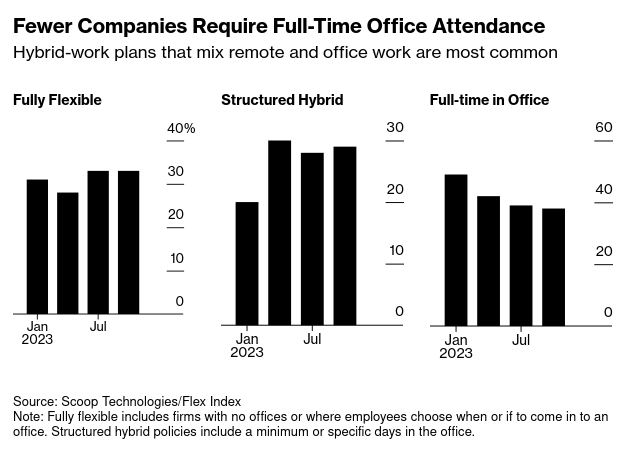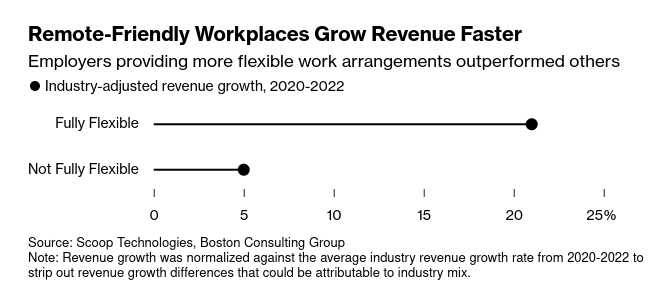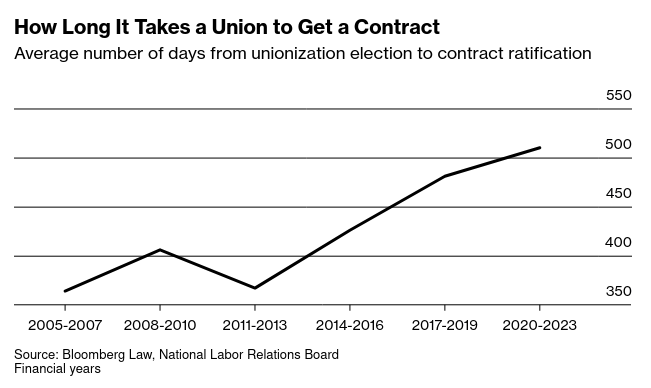November 15, 2023
More work from home data
It seems as though firms that allow hybrid arrangements out-compete those who do not.
A report from the Boston Consulting Group shows the impact quite clearly.

There is also a growing number of firms that offer work from home even from the start of they year.
The issues driving this:
- The best employees do not want to work for inflexible companies and managers.
- Productivity is higher.
The only folks who seem to do better coming into the office as a group are ladder climbing men. This group feels more "engaged" and sense of belonging—likely because they were able to cozy-up to the boss.
Given that the better employees are the ones who want more flexibility on work from home, it is likely firms who have a poor analysis of this will be dragged-down by opportunists over competent workers.

Increasing time to get a Collective Agreement is a major obstacle for unionization
Major organizing campaigns in the USA and Canada are being undermined by slow moving HR departments purposely undermining union efforts to get a contract. The result is increased frustration of employees directed at the union:

Tactics for labour organizing have always faced this kind of foot dragging. Labour legislation that is more permissive of capital's anti-union activities result in more pre-CA strike actions or abandonment of the unit compared to where protections are strong.
However, as technology and sophistication of HR departments continue to rise, unions must respond in kind. Investment in new technologies and analysis is necessary in this thin edge of the class war.
Water is the (not so new) battleground
A top focus of climate adaptation is going to be securing fresh water infrastructure. A lot of energy is already put into supporting and providing water for communities around the world, especially in water scarce areas.
Food supplies and life are necessary, but much of the investment activity is on usurping water supplies under a commodity market for production and export of food.
Desalination is a technology that is getting more attention from VC investors and those seeking to profit from the supply crunch. The contracts are increasingly tied to access to long-term export markets.
While technologies exist to support desalination and water reclamation. The issue is that investment in these new technologies—when lead by private capital—will cause famines the same as colonial laws that protected food export over the local population's needs did.
A new report from Bloomberg follows some of the water rights fights in Senegal and other places that are water limited.
Demand for water in greater Dakar is expected to increase around 300% in the next 25 years, according to a World Bank report last year that concluded the country is moving “dangerously close” to having insufficient water to meet its basic needs in 2050. Twenty-thousand hectares of thirsty animal feed for export can only make matters worse.
Bales of alfalfa are loaded onto trucks at African Agriculture’s Les Fermes de la Teranga. The crop currently feeds Senegal’s skeletal cows, but the company’s business plan calls for exporting 70% of the fodder to more valuable livestock in the Persian Gulf.
Timis turned to the Ndiael. In 2018 one of his companies based in the Cayman Islands bought out the Italians’ 50-year rights to 26,000 hectares of the nature reserve for $8 million. Three years later, African Agriculture was incorporated in Delaware, and it now oversees the project. Timis renamed it Teranga Farms, adopting a Wolof word that describes unstinting hospitality, a core Senegalese value.
Food insecurity
Statistics Canada outlined that:
The majority of food insecure families had incomes above the poverty line
Income alone cannot explain food insecurity. Rather, food insecurity stems from the interplay of various factors, including the stability of income, assets and debt, access to family and social supports, and the cost of living.
Overall, 11% of families had incomes below the poverty line. While these families were most vulnerable to food insecurity, with rates being nearly twice as high as the overall average (35% versus 18%), most families experiencing food insecurity had incomes above the poverty line. In all, about 8 in 10 families that faced food insecurity were above the poverty line.
And, 10% Toronto residents relies on food banks.
At what point do we specifically demand intervention of the state to directly provide public food distribution and logistics services?
I think it was a while ago.